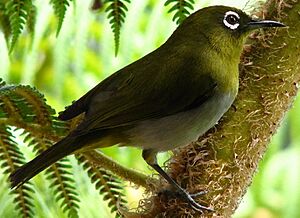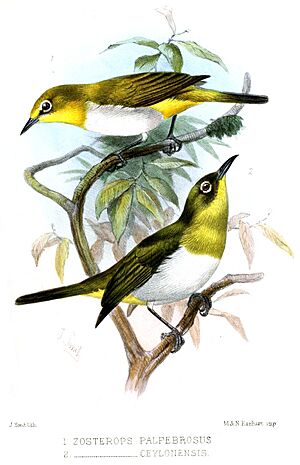Sri Lanka white-eye facts for kids
Quick facts for kids Sri Lankan white-eye |
|
|---|---|
 |
|
| Conservation status | |
| Scientific classification | |
| Genus: |
Zosterops
|
| Species: |
ceylonensis
|
The Sri Lanka white-eye (Zosterops ceylonensis) is a small bird that lives only in Sri Lanka. It is a type of passerine bird, which means it belongs to a large group of birds often called "perching birds." This bird is part of the white-eye family.
You can find the Sri Lanka white-eye living in forests, gardens, and farms, mostly in the high mountain areas of Sri Lanka.
Contents
About the Sri Lanka White-Eye
This bird is a bit bigger than the Indian white-eye. It is about 11 centimeters (4.3 inches) long. You will usually find it in areas above 1,200 meters (4,000 feet) in Sri Lanka.
Its body is mostly dark olive-green. The top of its head and forehead are a darker green. Its wings and tail are brown, but they have green edges on the back.
The Sri Lanka white-eye has a special feature: a ring of tiny white feathers around its eyes. This is how it got its name! It also has a dark area near its eyes and a dark line below them.
The bird's chin, throat, and upper chest are yellowish-green. Its legs are dark, and its eyes can be yellow or reddish-brown.
How to Tell Them Apart
It can be tricky to tell the Sri Lanka white-eye apart from the common Indian white-eye. But there are a few clues! The Sri Lanka white-eye is larger. Its back is a duller green. It also has more yellow on its chest. Plus, the dark patch between its eye and its beak is darker.
What They Eat and How They Live
Sri Lanka white-eyes are very social birds. They often form large groups. These groups usually stay together until it's time for them to build nests and have babies.
They build their nests in trees. The female bird lays three pale blue eggs. These eggs do not have any spots.
Even though these birds mainly eat insects, they also enjoy eating nectar from flowers. They also like to snack on different kinds of fruits.
The name "white-eye" comes from the clear white ring around their eyes. The scientific name, Zosterops, is a Greek word that means "girdle-eye." This also refers to the white ring.
In Sri Lankan Culture
In Sri Lanka, people call this bird Lanka Sithasiya in the Sinhala language. This bird is so special that it even appeared on a 35-cent Sri Lankan postage stamp! The stamp was first released in 1983.



